
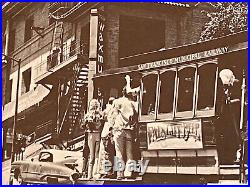
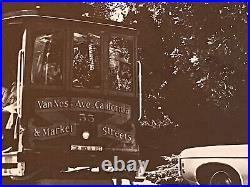
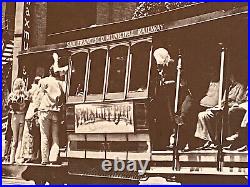
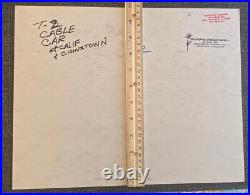
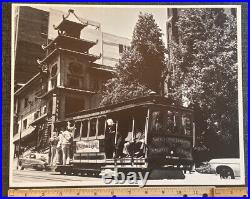

This stunning black and white photograph captures the beauty of San Francisco. The photographer, Royce Vaughn, has skillfully captured the essence of the city with this piece of art. The photograph is perfect for art collectors and those who appreciate fine photography. The photograph is of high quality and will make a great addition to any collection. It is perfect as a gift for friends and family who love San Francisco or photography. The subject of the photograph is the city’s iconic landmarks, which are beautifully showcased in black and white. This piece is a must-have for any art or photography enthusiast. This is part of the CALIFORNIA COLLECTION SERIES, which was also initiated by Royce Harris Vaughn. Size: approximately 11 x14 inches (about 28 vm x 35.5 cm). Back of photograph varies. Some are with stamps, some are without stamps, others have two stamps, some also bear the markings T2. Markings on backside made by artist. The image has been mounted on cardboard. The edges show slight blemishes (if you look closely). Please inspect images for exact condition. July 28, 1930 – June 17, 2015. Tenaciously — with great spirit, and always with just one more larger than life grand idea, one more story to tell — Royce Vaughn lived his declining years as a determined craftsman and dreamer until the end. Even as his health failed, his determination survived. Thanks to San Francisco Veterans Association Home Based Primary Care, Hospice by the Bay and strong Kindred caregivers, he was able to live at home. Born in Cleveland, Ohio, and running on the platform of “Royce, the People’s Choice”, he was elected Lt. Governor of Ohio Buckeye Boys’ State in 1948. That was the beginning of his public life after Miss Lyle and Nellie Rosebaugh, high school teachers he spoke of years later, admonished him to study. He was offered full scholarships to Yale, Harvard, Princeton and Antioch. Stories he told about his experiences there included meeting Albert Einstein, his majors in Renaissance art history and religion as well as his unprecedented integration of the prestigious Quadrangle Club. It was a period of his life that impacted him profoundly. Artistic skills in the US Army gave him the opportunity to serve as a General’s artist while in Augsburg, Germany, and craft shop director at Fort Ord in California. Once in San Francisco, he worked at Flax Art Supplies and at the San Francisco Chronicle where he and Bonanza editor Ted Brett won a first place Carl J. Nelson Newspaper Research Study award for major daily newspapers. Later, while in the audio visual department at San Francisco State, he was co-creator and first president of the Staff Assembly representing over 700 employees. In each period of his life, Vaughn conceived and developed projects built around the premise that creativity could and should be more than just a painting on the wall. He was an independent thinker, looking always for new ways to make a contribution, especially in training young people. In the Sixties he founded The Arts and Business Learning Experience (Project ABLE) to provide motivational job training for youth. The ABLE documentary “The Afro-American Thing” illustrated a series of events in local libraries and community centers and was aired on KPIX Channel 5. Now on YouTube, it reflects the excitement and awe of young people being introduced — perhaps for the first time — to poets, musicians, theater and an African dance group. Subsequent ABLE films made by 40 newly inspired students with the help of professional instructors were contracted by local corporations and government, including Pacific Telephone, the US Department of Labor and SF Chamber of Commerce. Next came the Oceanview/Merced/Ingleside Business League (OMIBL) which Royce created to encourage and strengthen the small business community in and around Ocean Avenue. He saw the future of the street as a link between San Francisco State University and City College of San Francisco and in 1998 produced a local history book and staged a parade from one end of the street to the other to promote neighborhood unity. He created an Opportunity Knocks program for young people, spearheaded the mural project on the PG&E building on Ocean Avenue and Junipero Serra, was actively involved in fundraising for the Broad Street Library, served as vice president of the San Francisco Council of District Merchants and won their Outstanding Association Member award in 2003. Art, as always, was his underlying strength. In early years, his pieces were primarily bold oils and acrylics featured in one-man shows at The Henry Gifford Hardy Gallery at the University Club, Bank of America, Nordstroms, I. Magnin, Jones Wesleyan Methodist Church, First Unitarian Church and private homes. Honoring his racial heritage and desire for a more understanding multi-cultural world, Royce created “We Shall Overcome, ” a 60″x36″ acrylic honoring civil rights leaders of the Sixties which was included in a 1996 juried show at the Museum of Science and Industry in Chicago. His “Remembering Our Heroes” portraits are of early African-American heroes Frederick Douglass, Booker T. Washington, George Washington Carver and Ralph Bunche. Modern Afrigrams are based on Chinese tangrams and executed in the colors of Africa. His work is listed in Afro-American Artists, Boston Public Library, New Perspectives in Black Art, Oakland Museum, Black Dimensions in Contemporary Art, Carnation Company, 1972 McGraw-Hill High School History Reader and the Slide Registry of the University of Southern Alabama. In later years what started out to be summer vacation treks became yet another venture — the creation of his company, the California Collectors Series, for which he painted more than 20 watercolors which he made into note cards depicting the quiet beauty of scenes throughout California. More than anything, Royce was a craftsman with an understanding of tools of his trade — from art and photography to building a model railroad panorama and a practical working respect for architectural and construction skills stemming from pride in his grandfather who had built a church in Starkville, Mississippi. Again, in the spirit of multi-cultural understanding, he and wife Judy hosted guests from the International Visitors Center for almost twenty years. Their dining room table overlooking Noe Valley was the venue not only of spirited family gatherings but of wonderfully satisfying international conversations. Royce leaves behind his brother Albert, wife Judy, daughter Lisa and husband David Olstad, daughter Cassie and husband John Hellman, sons Royce David and Jeffrey Harris Vaughn, plus grandchildren Wesley, Chris, Amani and Ayana. Published by San Francisco Chronicle from Jun.

